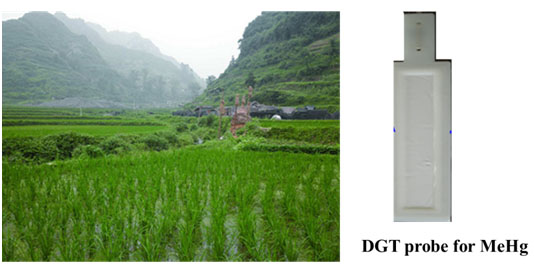 |
|
Rice paddy (left) and DGT probe for MeHg (right) (Images by IGCAS)
|
Methyl mercury (MeHg) is highly toxic to mammals and cause a number of adverse health effects. At inland Hg mining areas, rice consumption was the main MeHg exposure pathway, which was found by Prof. FENG Xinbin’s group of Institute of Geochemistry, Chinese Academy of Scineces (IGCAS). FENG’s group also discovered that the soil is the main source of MeHg in rice grain. Therefore, it is important to accurately assess the potential bioavailability of MeHg in paddy soils.
The diffusive gradient in thin films technique (DGT) is a new and widely published technique, which has been considered to be an accurate measure of the concentration of labile metal species in soil solution. Based on the principle of DGT, special DGT probes for MeHg were developed by FENG’s group. The scientists investigated MeHg dynamics and spatial MeHg trends in pore water during the rice grown season using the DGT technique and tested the ability of DGT to predict MeHg uptake by rice.
The MeHg concentration in pore water was monitored using DGT sediment probes over five successive time intervals from the day of planting. The mean DGT-measured MeHg concentration in each profile across the three sampling locations is correlated with the MeHg concentration in the soil, and that in plant root, stalk, and leaf (p< 0.01). Throughout the rice growing season, the pattern of temporal and spatial variation of MeHg concentration in pore water was similar at all three sites (Two Hg polluted sites and one control site). The vertical heterogeneity in DGT-measured MeHg concentration indicates that uptake of potentially labile MeHg may vary with depth.
To better understand the correlation between the DGT-measured MeHg concentration in soil and the MeHg concentration in rice, the average concentration of MeHg measured by DGT for each profile at each sampling time was calculated. A significant and strong positive correlation exists between the DGT-measured MeHg concentration in the pore water and the MeHg concentration in rice grain (R=0.768, p<0.05). This implies that DGT-measured MeHg is bioavailable to rice plants. The MeHg uptake flux from soil to rice plants via roots was also significantly correlated with the DGT-measured MeHg flux (R=0.853, p<0.01). The DGT technique was then demonstrated as a useful indicator of the likely ecotoxicological risk that might be apparent where paddy rice is grown in MeHg contaminated soil.
The use of DGT-measured mercury flux to predict uptake flux throughout a rice growing season could see the field deployment of DGT probes prior to rice seed formation. This would be a relatively inexpensive monitoring tool that could result in the action of crop removal and destruction before the contaminated food crop became ready for harvest. Therefore, it would effectively mitigate the risk of MeHg-contaminated rice entering the food chain in areas where rice is known to be the main pathway for human MeHg exposure.
The above work was published on Environmental Science & Technology (Liu et al., Prediction of methyl mercury uptake by rice plants (Oryza sativa L.) using the diffusive gradient in thin films technique. Environmental Science & Technology, 2012, 46(20): 11013-11020).
(By FENG Xinbin’s Group)